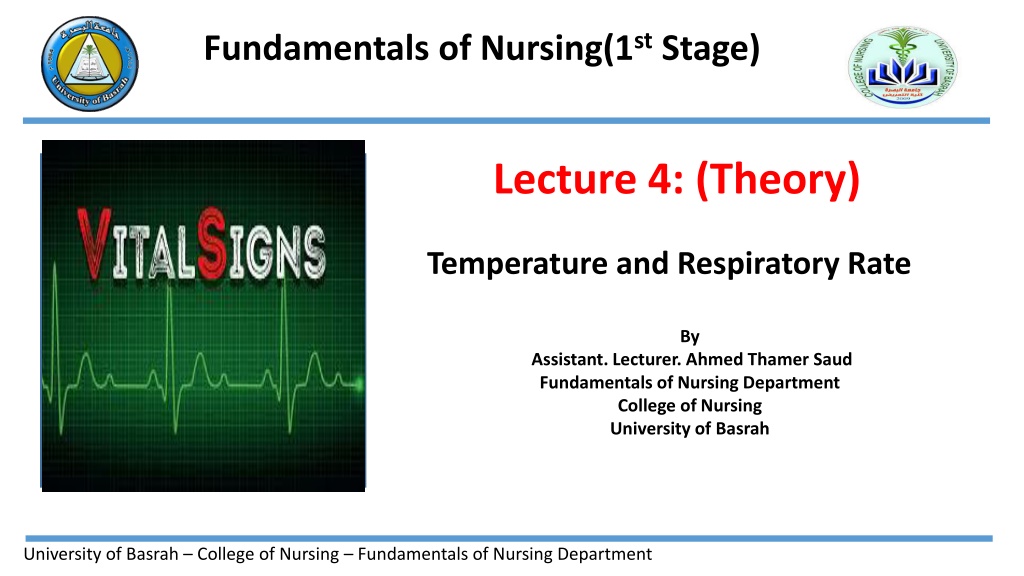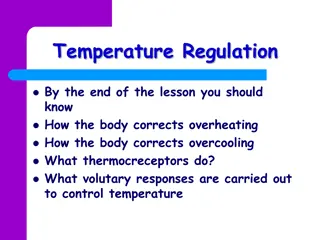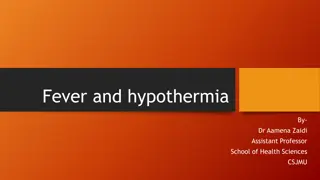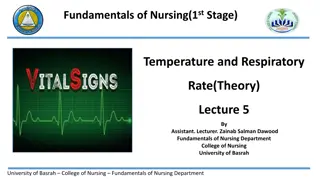Understanding Body Temperature Regulation in Nursing Practice
Body temperature regulation is a vital aspect of nursing care, involving the balance between heat production and loss. The core body temperature is controlled by the hypothalamus, responding to thermal receptors and hormonal cues to maintain homeostasis. Heat production mechanisms such as metabolism, hormonal influences, and physical exertion play critical roles, while heat loss primarily occurs through the skin. Nursing professionals must understand these physiological processes to assess and manage patients' temperature and respiratory rate effectively.
Download Presentation

Please find below an Image/Link to download the presentation.
The content on the website is provided AS IS for your information and personal use only. It may not be sold, licensed, or shared on other websites without obtaining consent from the author. Download presentation by click this link. If you encounter any issues during the download, it is possible that the publisher has removed the file from their server.
E N D
Presentation Transcript
Fundamentals of Nursing(1st Stage) Lecture 4: (Theory) Temperature and Respiratory Rate By Assistant. Lecturer. Ahmed Thamer Saud Fundamentals of Nursing Department College of Nursing University of Basrah University of Basrah College of Nursing Fundamentals of Nursing Department
Body Temperature Introduction Body temperature is the difference between the amount of heat produced by the body and the amount of heat lost to the environment measured in Centigrade or Celsius. Heat is generated by metabolic processes in the core tissues of the body, transferred to the skin surface by the circulating blood, and then dissipated to the environment. Core body temperature (intra-cranial, intra-thoracic, and intra- abdominal) is higher than surface body temperature. University of Basrah-College of Nursing Fundamentals of Nursing Department
Physiology of Body Temperature The core body temperature regulated by thermoregulatory center in the hypothalamus. This center receives messages from cold and warm thermal receptors located throughout the body, compares that information with its temperature set point, and initiates responses to either produce or conserve body heat or to increase heat loss. University of Basrah-College of Nursing Fundamentals of Nursing Department
Heat Production 1- The primary source of heat in the body is metabolism, to generate energy for cellular functions. 2- Various mechanisms increase body metabolism, including hormones and exercise. When additional heat is required to maintain balance, epinephrine and norepinephrine (sympathetic neurotransmitters) are released to rapidly alter metabolism so that energy production decreases and heat production increases. University of Basrah-College of Nursing Fundamentals of Nursing Department
3- Thyroid hormone, produced by the thyroid gland, also increases metabolism and heat production, but over a much longer time period. 4- Shivering, a response that increases the production of heat, is initiated by the hypothalamus and results in muscle tremors, causing the production of heat. In addition, the contraction of pilomotor muscles of the skin, as occurs with shivering, causes piloerection, or goose bumps, and reduces the surface area of skin available for heat loss. 5- Physical exertion increases heat production through muscle movements University of Basrah-College of Nursing Fundamentals of Nursing Department
Heat Loss 1- The skin is the primary site of heat loss. The circulating blood brings heat to the skin s surface, where small connections between the arterioles and the venules lie directly below the skin surface. 2- Physical processes of radiation, convection, evaporation, and conduction. 3- Evaporation of sweat, through warming and humidifying of inspired air, and through elimination of urine and feces. University of Basrah-College of Nursing Fundamentals of Nursing Department
Conduction: the transfer of energy from matter to adjacent matter by direct contact, without intermixing or flow of any material. University of Basrah-College of Nursing Fundamentals of Nursing Department
Convection: the transfer of energy by the bulk mixing of clumps of material. In natural convection it is the difference in density of hot and cold fluid which causes the mixing. University of Basrah-College of Nursing Fundamentals of Nursing Department
Radiation such as light, infrared, ultraviolet and radio waves which emanate from a hot body and are absorbed by a cooler body. University of Basrah-College of Nursing Fundamentals of Nursing Department
Evaporation: the conversion of liquid to vapor University of Basrah-College of Nursing Fundamentals of Nursing Department
Factors Affecting Body Temperature 1- Circadian Rhythms Circadian (meaning nearly every 24 hours) rhythm. For instance, body temperature is usually about 0.6 C lower in the early morning than in the late afternoon and early evening. The peak elevation of a person s temperature occurs in late afternoon and early evening, between 4 and 8 pm. University of Basrah-College of Nursing Fundamentals of Nursing Department
2- Age and Gender Older adults lose some thermoregulatory control with aging; body temperatures in older adults may be lower than the average adult temperature. Both the very old and the very young are more sensitive to changes in environmental temperature.. Women tend to experience more fluctuations in body temperature than do men, probably the result of changes in hormones. The increase in progesterone secretion at ovulation increases body temperature as much as 0.3 to 0.6 C. University of Basrah-College of Nursing Fundamentals of Nursing Department
3- Physical Activity Physical exertion increases body temperature. Increased metabolism resulting from muscle activity results in the production of heat. 4- State of Health The presence of certain disease conditions and other health problems may result in alterations in body temperature. University of Basrah-College of Nursing Fundamentals of Nursing Department
5- Environmental Temperature Most of us respond to changes in environmental temperature by wearing clothing that either allows increased heat loss when it is hot or retains heat when it is cold. When one is exposed to extreme cold without adequate protective clothing, heat loss may be increased to the point of hypothermia (low body temperature). Similarly, if one is exposed to extremes of heat for long periods of time, hyperthermia (high body temperature) may result. Both hypothermia and hyperthermia may cause serious illness or death. University of Basrah-College of Nursing Fundamentals of Nursing Department
Normal body temperature ranges from (36 C to 38 C) depending on the route used for measurement Example: Oral temperature 36.5 C Axillary temperature and Tympanic membrane temperature 37 C Rectal temperature 36 C University of Basrah-College of Nursing Fundamentals of Nursing Department
Increased Body Temperature 1- Fever (pyrexia): is an increase in body temperature above normal. ** Febrile: person with fever. Fever occurs in response to: an upward displacement of the thermoregulatory set point in the hypothalamus. Tissue injury, such as from myocardial infarction (MI), pulmonary emboli, cancer, trauma, and surgery. 2- Hyperpyrexia fever is equal to or greater than 41 C and is a medical emergency. University of Basrah-College of Nursing Fundamentals of Nursing Department
3- Other types of increased body temperature are hyperthermia, neurogenic fever, and fever of unknown origin (FUO). Hyperthermia differs from fever in that the hypothalamic set point is not changed, but in situations of extreme heat exposure or excessive heat production (e.g., during strenuous exercise). Neurogenic fever is the result of damage to the hypothalamus from pathologies such as intracranial trauma, intracranial bleeding, or increased intracranial pressure. Fever of unknown origin (FUO): fever of 38.3 C or higher that lasts for 3 weeks or longer without an identified cause. University of Basrah-College of Nursing Fundamentals of Nursing Department
Physical Effects of Fever Patients with fever may experience: 1. loss of appetite; headache; hot, dry skin; flushed face; thirst; muscle aches; and fatigue. 2. Respirations and pulse rate increase. 3. Seizures occur in (Young children). While confusion and delirium in (older adults). 4. Fever blisters may develop in some people. University of Basrah-College of Nursing Fundamentals of Nursing Department
Nursing Interventions for Hyperthermia Monitor environmental factors like room temperature and bed linens as indicated. Eliminate excess clothing and covers. Give antipyretic medications as prescribed. Ready oxygen therapy for extreme cases. Modify cooling measures based on the patient s physical response. Raise the side rails at all times. Start intravenous normal saline solutions as indicated. Provide high caloric diet or as indicated by the physician. University of Basrah-College of Nursing Fundamentals of Nursing Department
Decreased Body Temperature Hypothermia:is a body temperature below the lower limit of normal. Causes of Hypothermia: 1- unprotected exposure to cold environments. 2- Chronic conditions such as alcoholism, malnutrition, and hypothyroidism University of Basrah-College of Nursing Fundamentals of Nursing Department
Physical Effects of Hypothermia 1. Patients with hypothermia may experience poor coordination, slurred speech, poor judgment, amnesia, hallucinations, and stupor. 2. Respirations increase, and the pulse becomes weak and irregular, with lowering blood pressure. Treatment of Hypothermia ** Treatment of hypothermia includes rewarming the patient. Rewarming can be accomplished by covering with additional clothing and blankets, the use of heating blankets and pads, and radiant warmers. Warm fluids are administered orally or through the intravenous route. University of Basrah-College of Nursing Fundamentals of Nursing Department
Nursing Intervention for Hypothermia 1.Note and monitor patient s temperature. 2.Monitor the patient s HR, heart rhythm, and BP. 3.Evaluate the patient s nutrition and weight. 4.Monitor fluid intake and urine output 5.Check for electrolytes, arterial blood gases, and oxygen saturation by pulse oximetry. 6.Evaluate for the presence of frostbite, if the patient has had prolonged exposure to a cold environment. 7.Assess the patient s typical pattern of urination and occurrence of incontinence. University of Basrah-College of Nursing Fundamentals of Nursing Department
RESPIRATIONS Introduction Respiration involves ventilation, diffusion, and perfusion. Ventilation (or breathing) is movement of gases in and out of the lungs; inspiration (or inhalation) is the act of breathing in, and expiration (or exhalation) is the act of breathing out. Diffusion is the exchange of oxygen and carbon dioxide between the alveoli of the lungs and the circulating blood. Perfusion is the exchange of oxygen and carbon dioxide between the circulating blood and tissue cells. University of Basrah College of Nursing Fundamentals of Nursing Department
Physiology of Respirations The rate and depth of breathing can change in response to tissue demands. These changes are brought about by the inhibition or stimulation of the respiratory muscles by the respiratory centers in the brain. Activation of the respiratory centers occurs via: Impulses from chemoreceptors located in the aortic arch and carotid arteries Stretch and irritant receptors in the lungs, Receptors in muscles and joints. An increase in carbon dioxide is the most powerful respiratory stimulant, causing an increase in respiratory depth and rate. University of Basrah College of Nursing Fundamentals of Nursing Department
Factors Affecting Respirations Many different factors affect respiratory rate and depth. These factors include: 1. Exercise 2. Respiratory and cardiovascular disease 3. Alterations in fluid, electrolyte, and acid base balances 4. Medications 5. Trauma 6. Infection 7. Pain 8. Emotions University of Basrah College of Nursing Fundamentals of Nursing Department
Normal Respiratory Rate Under normal conditions, healthy adults breathe about 12 to 20 times each minute. infants and young children breathe more rapidly. Normal, unlabored respiration is called eupnea. University of Basrah College of Nursing Fundamentals of Nursing Department
Increased Respiratory Rate Tachypnea: an increased respiratory rate, may occur in response to an increased metabolic rate, such as when a person has a fever. Cells require more oxygen at this time and produce more carbon dioxide that must be removed. The rate increases as much as 4 breaths/min with every 0.6 C that the temperature rises above normal. Any condition causing an increase in carbon dioxide and a decrease in oxygen in the blood increases the rate and depth of respirations, hyperventilation. University of Basrah College of Nursing Fundamentals of Nursing Department
Decreased Respiratory Rate Bradypnea: decrease in respiratory rate, occurs in some pathologic conditions: An increase in intracranial pressure depresses the respiratory center, resulting in irregular or shallow breathing, slow breathing, or both. Certain drugs, such as opioids (e.g., morphine) can depress the respiratory rate. University of Basrah College of Nursing Fundamentals of Nursing Department
Respiratory Depth and Rhythm The depth of respirations normally varies from shallow to deep. The depth of each respiration is about the same when resting or sleeping. Periodically, each person automatically inhales deeply , filling the lungs with more air than with the usual depth of respiration. University of Basrah College of Nursing Fundamentals of Nursing Department
Assessing Respirations The nurse assesses: 1. Respiratory rate (breaths per minute). 2. Depth (deep or shallow) 3. Rhythm (regular or irregular) Other methods of assessing respiratory effectiveness include: Monitoring arterial blood gas results Using a pulse oximeter to determine oxygenation of blood. University of Basrah College of Nursing Fundamentals of Nursing Department
University of Basrah College of Nursing Fundamentals of Nursing Department























